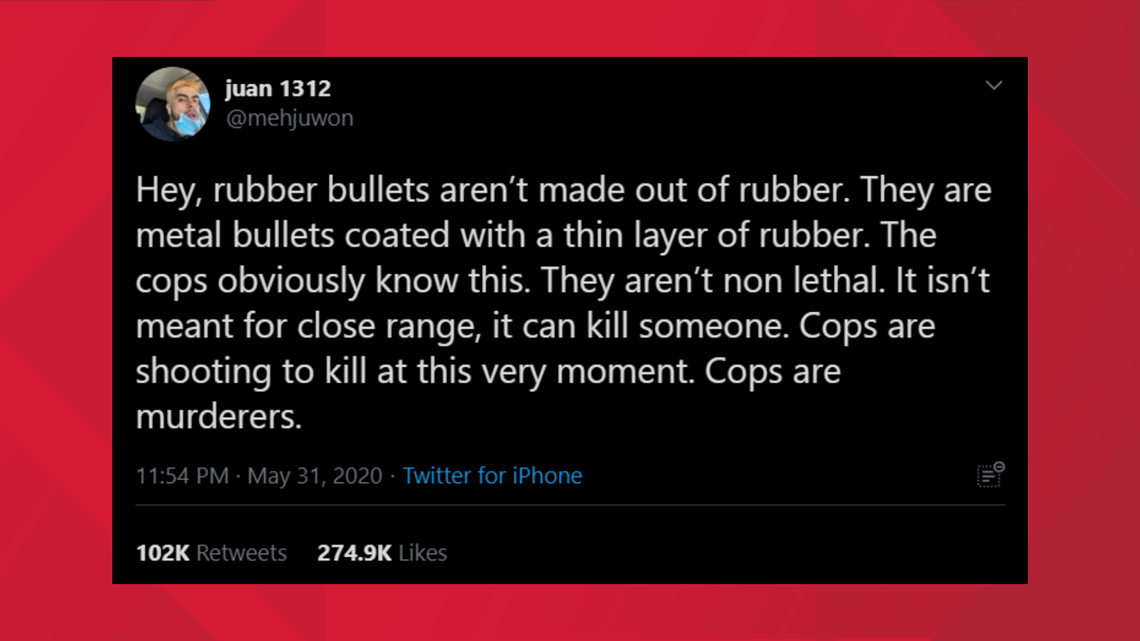There have been countless videos and photos from across the country of police officers dispersing protesters with tear gas and rubber bullets over the last several days.
Rubber bullets are generally thought of as a non-lethal way to break up restless crowds. However, a viral tweet claimed that rubber bullets aren't non-lethal at all. In fact, the tweet says rubber bullets are metal bullets with a rubber coating that can still kill someone.


Is that description of rubber bullets accurate?
THE QUESTION
Are rubber bullets made of rubber only or are they rubber-coated metal? Are they dangerous enough to kill people?
THE ANSWER
Rubber bullets can be either entirely rubber or they may be a rubber-coated metal disk.
They can kill people and some classify them as "less lethal" weapons instead of non-lethal. They are more likely to cause serious injury or be fatal when used at close range and aimed at parts of the body with vital organs, like the head or the chest.
WHAT WE FOUND
An American Civil Liberties Union document classifies rubber bullets as less lethal weapons, often used for crowd control in riots, protests or other situations in which lethal weapons such as firearms would be too dangerous.
Manufacturers worldwide produce more than 75 types of rubber or plastic bullets and launchers, which are marketed to military, police and private security forces, according to the National Center for Biotechnology Information, which is under the National Institutes of Health.
The NCBI found “limited public information provided by manufacturers on their design and guidelines for use,” so it’s hard to know exactly what’s in them. In a quick check of two Dallas-area gun sellers, both said their rubber bullets were all rubber, with shells containing rubber pellets.
It analyzed 26 studies of 1,984 injuries, including 53 deaths, from crowd control weapons from 1990 to 2017. In addition to rubber bullets, the study looked at plastic bullets, bean bag rounds, shot pellets and other projectiles.
“Kinetic impact projectiles (KIPs), often called rubber or plastic bullets, are used commonly in crowd-control settings. We find that these projectiles have caused significant morbidity and mortality during the past 27 years, much of it from penetrative injuries and head, neck and torso trauma,” the NCBI said. “Given their inherent inaccuracy, potential for misuse and associated health consequences of severe injury, disability and death, KIPs do not appear to be appropriate weapons for use in crowd-control settings.”
The NCBI report said more injuries and deaths occurred from the rubber-coated metal bullets and those with metal composites. In its conclusion, it called for restrictions on the use of those bullets.
The same NCBI study said death, severe injuries and permanent disability are more likely to occur from close-range bullet shots aimed at the head, neck, chest or abdomen. Protocol on using rubber bullets often "instruct law enforcement to use the weapons from a ‘safe distance’ and to aim at soft musculature of the lower limbs." The study points out that safe shooting distances are not well validated and are highly variable between weapons, manufacturers and countries.
There have been no reported deaths to rubber bullets in the past week's protests, although people have been injured by them. One of the most high-profile rubber bullet injuries was on May 29 when Linda Tirado, a freelance photographer, was shot in the left eye by a rubber bullet while covering the George Floyd street protests, The New York Times reported. Tirado said on Twitter that she has lost sight in that eye.

